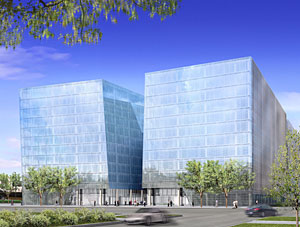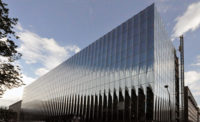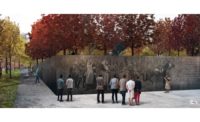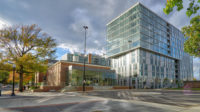Although Chicago-based Krueck + Sexton is well known for projects like Millennium Park’s Crown Fountain or the Spertus Institute of Jewish Studies on Michigan Avenue, the 18-year-old architecture firm is designing its first speculative office project just now.

Developer Tishman Speyer commissioned Krueck + Sexton to design two 12-story, glass-clad office buildings in Washington, D.C.
Developer Tishman Speyer commissioned Krueck + Sexton to design two 12-story, glass-clad office buildings in Washington, D.C.’s emerging North of Massachusetts Avenue neighborhood, or NoMa. Currently one tower is under construction and will be completed by the second quarter of 2009.
In a city rarely noted for exemplary commercial office architecture, Krueck + Sexton’s design defies boxy conventions by featuring a diagonal refracted crease in its north-facing glass curtain wall. The building, 1100 First Street NE, subtly shifts its volume outward along this axis, deriving much of its expression from this gesture. Its twin, which will be erected immediately to the north, mirrors this subtle shift in massing; the two will essentially “orbit each other,” describes Mark Sexton, FAIA.
Entrances to both buildings are pulled back under a slight cantilever, allowing visitors to experience the thinness of the overhanging glass curtain wall. The architects are targeting LEED Gold certification for the two buildings; the entire NoMa neighborhood is part of the USGBC’s LEED for Neighborhood Development pilot program.
Buildings like Krueck + Sexton’s are part of a new crop of glass-walled D.C. offices casting off perceived obligations to impersonate somber monuments and government landmarks. Murphy/Jahn has one such building under construction downtown, and Polshek Partnership’s glass Newseum opened on Pennsylvania Avenue last April. “This city more than any other really had a tough bout with Postmodernism, and with trying to deal with some beautiful old limestone buildings,” says David Epstein, AIA, a design director at Gensler’s Washington office. His firm is the architect of record for 1100 First Street NE; it also designed PNC Place, another glass-walled office building now under construction in downtown D.C.
The move from limestone-and-masonry mimicry to glassy offices, Epstein says, has been driven by developments in curtain wall technology, most notably the heightened versatility and flexibility of curtain wall systems. In addition, as D.C.–based lobbyists and law firms establish daylight-filled, open branches in other cities, those tenants are asking architects and developers to achieve those same qualities for their home offices.




Post a comment to this article
Report Abusive Comment